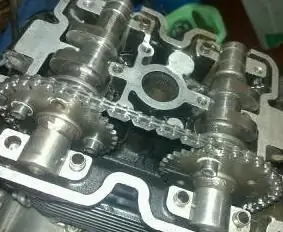2025 Author: Erin Ralphs | [email protected]. Last modified: 2025-06-01 05:35:55
A constant velocity joint (CV joint) is a device that transmits torque from the transmission to the leading axle shafts of the vehicle. It is completed in pairs, on one of the axles of the car. What is an external CV joint and how it works - you will find out in today's article.

Destination
Outer CV joint (including VAZ 2115) is an integral part of an independent suspension. Those wheels that do not transmit torque, i.e. are not leading, are not equipped with these hinges. One of the main features of this mechanism is its ability to provide a tilt angle of up to 70 degrees, which makes it possible to use it in the design of the leading axle.
Where is it hosted?
As a rule, most modern cars are equipped with hinges on the front axle, since their running system is mainly front-wheel drive. On all-wheel drive vehicles, the outer CV joint is equipped on both axles, since all 4 wheels provide drive and movement of the car. Accordingly, on rear-wheel drive, this device is located on the rear axle. However, in the last two cases, the CV joint can only be placed on the condition that the vehicle has an independent suspension and that this wheel has an unsynchronized ability to move in a vertical and horizontal plane.

When the articulation angle is small, the transmission of forces from the transmission is easily handled by the universal joint of unequal speeds. When this value of the angle increases, the shaft begins to rotate unevenly, which complicates the work of transmitting torque. As a result, the car loses power and becomes less dynamic. To prevent this from happening, a CV joint (external and internal) is installed on the machine.
What is the difference between an inner hinge and an outer hinge?
Most often, two types of CV joints are used in the gearbox of front-wheel drive vehicles - external and internal. This is done in order to provide greater freedom of movement of the shaft. And if their principle of operation and purpose - the transfer of forces from the transmission to the drive wheels - are unchanged, then two main differences can be noted in the design.
- The outer CV joint is installed directly at the wheel itself and is equipped with a ball joint at the end of the drive shaft.
- The inner one mates with the transmission case and is completed with a tripod joint in the same place.
Lifetime
The outer CV joint, however, like the inner one, is the most "survivable" part of all that is in the suspension. Due to its simple, and at the sametime reliable, their design life can reach 100, 150, and in some cases even 200 thousand kilometers. However, one should not forget that the "survivability" of this mechanism directly depends on the condition and timely replacement of anthers.

SHRUS outer - price
The cost of this device in the Russian market averages from 500 to 2-3 thousand rubles. The price may change up or down depending on which car this or that CV joint is used on.
Recommended:
Engine gas distribution mechanism: device, principle of operation, purpose, maintenance and repair

Timing belt is one of the most critical and complex components in a car. The gas distribution mechanism controls the intake and exhaust valves of an internal combustion engine. On the intake stroke, the timing belt opens the intake valve, allowing air and gasoline to enter the combustion chamber. On the exhaust stroke, the exhaust valve opens and exhaust gases are removed. Let's take a closer look at the device, the principle of operation, typical breakdowns and much more
The principle of operation of the variator. Variator: device and principle of operation

The beginning of the creation of variable programs was laid in the last century. Even then, a Dutch engineer mounted it on a vehicle. After such mechanisms were used on industrial machines
Purpose, features of the device and the principle of operation of the car starter

As you know, to start a car engine, you need to turn the crankshaft several times. On the first machines, this was done manually. But now all cars are equipped with starters that allow you to rotate the shaft without any effort. The driver only needs to insert the key into the lock and turn it to the third position. Then the motor will start without problems. What is this element, what is the purpose and principle of operation of the starter? We will talk about this in our today's article
"Lada-Kalina": ignition switch. Device, principle of operation, installation rules, ignition system, advantages, disadvantages and features of operation

Detailed story about the ignition switch Lada Kalina. General information and some technical characteristics are given. The device of the lock and the most frequent malfunctions are considered. The procedure for replacing with your own hands is described
What is a turbo timer: the purpose of the gadget, the device and the principle of operation

The active use of turbocharged engines has made the use of electronic gadgets that improve their performance relevant. The turbo timer is one of them. Its use significantly extends the life of turbines. Read more about what a turbo timer is, about the principle of its operation and the benefits for the engine, read the article

